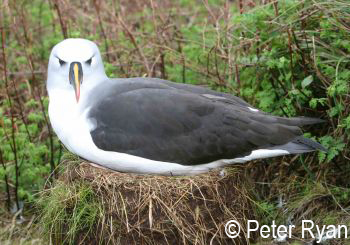The United Kingdom’s Royal Society for the Protection of Birds (RSPB) has recently been awarded two separate grants, one from the Albatross and Petrel Agreement’s Advisory Committee (click here), the other from “Darwin Plus”, the UK’s Overseas Territories Environment and Climate Fund, that together will lead to an assessment of the global population size of the ACAP-listed and Endangered Atlantic Yellow-nosed Albatross Thalassarche chlororhynchos at its breeding grounds in the Tristan da Cunha Island group.

Atlantic Yellow-nosed Albatross on its nest
Photograph by Peter Ryan
Because of the rugged and in parts inaccessible terrain of the Tristan islands ground surveys are particularly hard to undertake, so the plan is to conduct photographic surveys of breeding yellow-nosed albatrosses by helicopter. It is intended to undertake the aerial surveys in September this year during the incubation period when nest occupation levels are expected to be at their highest.
The logistic support of South Africa’s Antarctic research and supply ship, the S.A. Agulhas II, which carries two helicopters, will be sought when it conducts the annual relief of the South African meteorological station on Gough Island. During the relief the ship will also visit the main island of Tristan da Cunha.
The population figures for each island surveyed will be obtained from sequential overlapping aerial photographs taken at low altitude. The photographs will be merged using software to form photomontages following standard protocols and capitalising on recent advances in imaging quality and processing. Apparently occupied nests can then be relatively accurately counted from these montages on-screen.
The RSPB will work closely with the Tristan Conservation Department which will assist by providing the teams that will undertake the necessary ground truthing on both Gough and Tristan. If time and weather allows, aerial photography will also be undertaken at Nightingale and Inaccessible Islands. If all four islands are surveyed then the resulting census will result in the first-ever accurate annual breeding population figure for the species, which is endemic to the four Tristan islands and the islets of Middle and Stoltenhoff next to Nightingale.
The need for such a survey was identified by ACAP’s Advisory Committee at its 2013 meeting (AC7) in La Rochelle, France. As part of the project the Tristan Conservation Department will be guided to expand its existing monitoring programme for Atlantic Yellow-nosed Albatrosses on Nightingale and Tristan to allow the ongoing assessment of population trends “which combined with the full census, would allow the conservation community to observe whether existing conservation measures are achieving conservation targets for this species, and whether other actions are needed to prevent population declines.”
With thanks to Clare Stringer, RSPB UK Overseas Territories Unit for information.
Selected Literature:
Cuthbert, R.J., Cooper, J. & Ryan, P.G. 2014. Population trends and breeding success of albatrosses and giant petrels at Gough Island in the face of at-sea and on-land threats. Antarctic Science 26: 163-171.
Cuthbert, R., Ryan, P.G., Cooper, J. & Hilton, G. 2003. Demography and population trends of the Atlantic Yellow-nosed Albatross. The Condor 105: 439-452.
John Cooper, ACAP Information Officer, 05 April 2014

 English
English  Français
Français  Español
Español